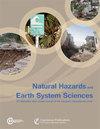历史上古地震的足迹:公元6世纪发生在欧洲西南阿尔卑斯山的地震
IF 4.7
2区 地球科学
Q1 GEOSCIENCES, MULTIDISCIPLINARY
引用次数: 0
摘要
摘要低变形区地震重复周期长。在这里,为了正确评估地震危险,尽可能地追溯过去的事件记录是至关重要的。来自单一地点或代理的证据可能并不令人信服,而我们从多个地点的古和考古地震证据的整合中获得了更实质性的画面,最终补充了历史编年史。在科莫市(意大利北部),我们对Via Manzoni的沉积序列进行了地层学和沉积学分析,并通过运动和实地调查的方式记录了罗马浴场的地震考古影响。放射性碳测年法和考古遗址的年代限制使我们能够将变形发生的时间确定为公元六世纪。我们将观测到的变形解释为由于地震引起的地面震动,并提供了触发此类证据的下限限制。通过利用瑞士和意大利北部湖泊已公布的古地震证据数据集,我们转向区域视角来推断可能的相关震源。我们执行逆网格搜索,以确定地震的震级和位置,这可以解释与科摩事件时间间隔一致的所有正面和负面证据。我们的研究结果表明,震中位于意大利和瑞士边界的地震(最小Mw 6.32)可能解释了所有观测到的影响;在公元6世纪发生的类似事件至今没有史料记载。我们的研究呼吁有必要完善当地地震危险的特征,特别是考虑到该地区似乎没有准备好面对类似于公元6世纪事件推断的地震规模的影响。本文章由计算机程序翻译,如有差异,请以英文原文为准。
The footprint of a historical paleoearthquake: the sixth-century-CE event in the European western Southern Alps
Abstract. Low-deformation regions are characterized by long earthquake recurrence intervals. Here, it is fundamental to extend back the record of past events as much as possible to properly assess seismic hazards. Evidence from single sites or proxies may be not compelling, whereas we obtain a more substantial picture from the integration of paleo- and archeoseismic evidence at multiple sites, eventually supplemented with historical chronicles. In the city of Como (N Italy), we perform stratigraphic and sedimentological analyses on the sedimentary sequences at Via Manzoni and we document earthquake archeological effects at the Roman baths by means of structure from motion and field surveys. Radiocarbon dating and chronological constraints from the archeological site allow us to bracket the time of occurrence of the deformations to the sixth century CE. We interpret the observed deformations as due to earthquake ground shaking and provide constraints on the lower threshold for the triggering of such evidence. We move toward a regional view to infer possible relevant seismic sources by exploiting a dataset of published paleoseismic evidence in Swiss and N Italy lakes. We perform an inverse grid search to identify the magnitude and location of an earthquake that can explain all the positive and negative evidence consistent with the time interval of the event dated at Como. Our results show that an earthquake (minimum Mw 6.32) with epicenter located at the border between Italy and Switzerland may account for all the observed effects; a similar event in the sixth century CE has not been documented so far by historical sources. Our study calls for the need to refine the characterization of the local seismic hazard, especially considering that this region seems unprepared to face the effects of an earthquake size similar to the one inferred for the sixth-century-CE event.
求助全文
通过发布文献求助,成功后即可免费获取论文全文。
去求助
来源期刊
CiteScore
7.60
自引率
6.50%
发文量
192
审稿时长
3.8 months
期刊介绍:
Natural Hazards and Earth System Sciences (NHESS) is an interdisciplinary and international journal dedicated to the public discussion and open-access publication of high-quality studies and original research on natural hazards and their consequences. Embracing a holistic Earth system science approach, NHESS serves a wide and diverse community of research scientists, practitioners, and decision makers concerned with detection of natural hazards, monitoring and modelling, vulnerability and risk assessment, and the design and implementation of mitigation and adaptation strategies, including economical, societal, and educational aspects.

 求助内容:
求助内容: 应助结果提醒方式:
应助结果提醒方式:


